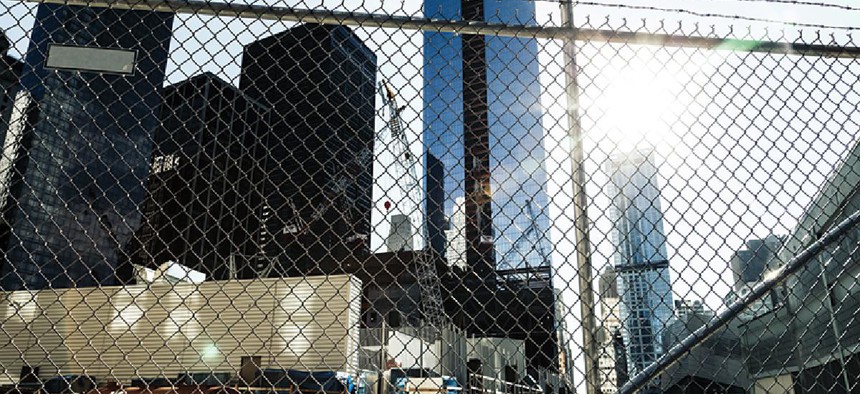In New York state, construction is king. From massive infrastructure projects, such as the replacement of the Tappan Zee Bridge with the Gov. Mario M. Cuomo Bridge, to the constantly evolving urban landscape of New York City, the state has one of the most active, storied and experienced building industries in the country. And with new upstate projects popping up across the region’s cities and small towns in recent years – many of them primed with lucrative incentives as part of Gov. Andrew Cuomo’s aggressive economic development policies – the frenzy has only grown in its furious pace.
But with so many large and complex projects playing out in a state where politics also reigns, the debates over policy can be intense. Whether it’s pushing for more minorities and women to be awarded state contracts, trying to cut through some of the bureaucratic red tape that can make projects infuriatingly expensive and slow, or arguments over whether government investments aimed at creating jobs bring a good return for taxpayers, battles are constantly being waged over policy at the state Capitol and in city halls across New York.
To better understand a few of these issues and where they stand as state lawmakers gear up for another legislative session, we spoke with Rick Chandler, commissioner of the New York City Department of Buildings, Assemblywoman Rodneyse Bichotte, who chairs the subcommittee on oversight of Minority and Women-Owned Business Enterprises and Polly Trottenberg, commissioner of the New York City Department of Transportation.
RELATED: Five questions about the Gateway Program, answered
Rick Chandler
Commissioner, New York City Department of Buildings
C&S: Your department just introduced a new online construction dashboard, with lots of colored, interactive graphs showing permits filed, the biggest projects each quarter and more. It’s pretty, but what’s the point?
RC: (laughs) Thank you for the highlights of our color scheme. Why we do it? The thing that I have been preaching to my staff, and actually to City Hall as well since we started, is that the department sits on a mountain of data, always has. And my goal after starting here was to start leveraging this information for a variety of reasons. Having this information at our fingertips helps us to better understand how we can assign our resources. The goal here is to walk that dual imperative we have: to provide the best customer service, but also the enforcement and safety aspects of the construction industry. So with this information, we can try to identify trends for our service levels, which we need to work on and monitor, but also trends for a variety of other things like potential risks related to various types of work. And then also potential risks related to various contractors, applicants, owners, etc. This is kind of the tip of the iceberg of what we have and we have created a very robust analytics section within our agency, including a robust mapping team, and we think that this is going to prove to be very, very useful for our agency, but also for New Yorkers in general and the industry.
C&S: Is that data that you were already using within the department that you’re now just making public? Or is this a new data?
RC: It’s a little bit of both. As we created our analytics division and a chief analytics officer, in conjunction with a risk unit, we are doing things differently than what we’ve done before. And we’re asking our employees to think a little bit differently. And again, this is new, so this is an ongoing culture change, which is what the mayor asked me to do when we started here. So this is an ongoing change within the agency. But it’s also something that we’re committed to doing to provide the public with as much transparency as possible. Our commitment, with our Building One City strategic plan that we started three years ago, was to commit to transparency, so we’re constantly focused on how we show everybody what we are doing because we think that transparency is absolutely imperative to integrity. So that’s something else that we’ve committed to.
Part of that effort is to supply as much information to the public, but also to continue to add information to the city’s Open Data Portal. Because that’s something that was started in the last administration and certainly Mayor de Blasio has absolutely committed to it. And we are proud of the fact that we are continually putting more information into that portal, and that will continue to grow. Because we think the private sector will do some amazing things with this information once they have the ability to access it. So we will continue to grow that information that we make public.
C&S: And you have another online platform, DOB NOW. Who’s that for?
RC: I love talking about this, because this is our main focus of our modernization effort. And that is to get virtually everything that we do into an online platform so that we can continually improve our services so that people don’t have to come down here, don’t have to wait in line. They can print their permits from their office. They can track applications in real time.
So that’s on the development side of what we do, but there’s very robust portions of DOB that’s related to inspections, licensing and also the mandated safety filings. So we have four suites, if you will, of DOB NOW, and that’s build, inspections, safety and licensing. We’ve been hauling out various things in the last couple of months.
C&S: Nobody likes sidewalk sheds. Is there anything the Department of Buildings can do to limit them on streets? City Councilman Ben Kallos has legislation that would limit that kind of scaffolding to six months. Do you support that legislation?
RC: We’re very aware of the inconvenience and some of the frustrations related to sheds … The mayor, with all these town halls that he’s been going to, it’s a question that comes up on virtually every town hall and he has requested that we provide some draft plan so that we might address some of those very issues that Council member Kallos is concerned about. I’m not sure his legislation, the way it’s drafted, is something we can support in its current form. Six months is certainly laudable, but I’m not sure how realistic it is, so we’re happily engaged in trying to explain the challenges around that. But (we) are totally committed, as is he and other council members, to try to address this issue. Such sheds have made a huge impact on the city, and we’d like to do something about it.
C&S: A construction safety bill, Intro 1447, passed in October. You testified in January that you didn’t like the apprenticeship requirements, but it got rewritten a number of times. Were you happy with the final form of the bill? Do you think it’ll save lives? Will it cost construction jobs?
RC: Training is absolutely a key component of safety at any job site. So to that extent, I am wholeheartedly in support of that legislation. We feel like we have significant expertise in construction safety and, something that’s not widely known, is that we have (a) very robust system of engaging the industry in asking their opinion and offering their expertise. As you might imagine, the things we might enforce, in terms of cranes, sheds and any number of things, we need expertise from the industry. So we have a built-in system to engage with those folks, so this legislation really accentuates that tool that we are currently using, and so to that extent, I support that. And we think, with this task force, that some significant training issues will be addressed, and we think we’ll be able to help the industry.
Now, as a comes to enforcing it and seeing the individual fights (?) and how they are complying, that poses a very significant challenge to us, and it’s something that is an ongoing discussion here, how we are going to have to restructure some of our current mandated inspections. So we’re undergoing that evaluation right now. The first thing on our plate is to get this task force assembled and get the various experts in. We have a March 1 deadline that we’re committed to and then the operationalizing of the law is an ongoing discussion here, which will be coming into shape over 2018.
C&S: You have said that construction was halted at Rivington House, the nursing home for HIV patients where the city lifted a deed restriction to allow it do be commercially developed. Is that still true, while the situation is being sorted out?
RC: We’ve issued one permit, to my knowledge, to allow some structural investigation there. We are working with their attorneys to clarify the extent of work that we’re permitting right now. And that’s related to their investigation of the structural system of the building, which does involve some minor demolition. So that’s been the ongoing permit that we have issued.
C&S: You sound like you’re staying on, but I have to ask with the mayor’s second term starting, are you planning on staying on?
RC: Yes, I’m fully committed at this time, absolutely. We were just evaluating earlier this week and in ongoing discussions today that we’re not quite halfway through this DOB NOW system and we’ve got a lot of heavy-duty stuff coming up in 2018 so we’re committed and excited about it.
RELATED: NYC again looks to the state for design-build authorization
Rodneyse Bichotte
Chairwoman, Assembly Subcommittee on Oversight of Minority and Women-Owned Business Enterprises
Assemblywoman Rodneyse Bichotte has made helping minority- and women-owned businesses become established in industries where they have traditionally been excluded a focal point in her public service. As the chairwoman of the Assembly’s MWBE subcommittee, she has been directly involved in ongoing conversations with contractors and trade associations. She recently spoke with City & State about the ways she can best help these businesses get a leg up.
C&S: Why is it important to have these goals to award more government contracts to MWBEs at all? Why not just let the construction industry continue to operate as it has without such intense tracking of these numbers?
RB: The MWBE program was put in place to rectify and to repair all that was taken and excluded for many, many years. The city and the state have a majority population of women and minorities, yet the number of contracts that’s going to these groups, it’s not reflective of the population.
C&S: What can New York City and state government do to help these firms beyond tracking the MWBE participation rates?
RB: We need funding to expand certification programs. We need funding to build capacity across the state and we need more money for our capital access. Empire State Development has mentioned that there is $185 million in revolving loan funds over the course of four years. That is not enough. That is miniscule. Yes, it’s a first step in the right direction, but we need to think bigger.
C&S: Is there any way you can get private sector businesses to help reach these goals?
RB: We have billions of dollars that we’re investing with different financial institutions. A very tiny percentage of that should go to a fund that would be bridge loans to MWBEs and so forth. We do business with these banks. These banks should have a commitment to the community as well.
RELATED: Construction industry questions MWBE targets numbers
Polly Trottenberg
Commissioner, New York City Department of Transportation
As the commissioner of the New York City Department of Transportation, Polly Trottenberg is quite familiar with the extremely complex and often frustrating processes for building in the city. Now, as state lawmakers ponder expanding a building program utilized by several state agencies, there may be some relief on the way. If the law passes and New York City agencies are able to utilize the design-build procurement method, it could cut construction times and save money on public projects. Trottenberg spoke with City & State about the potential impact.
C&S: It’s easy to see why contractors and developers would prefer this method of procurement. Why should average citizens care about it?
PT: Saving money and time is profoundly important, particularly in this city and this state. We have among, if not the highest, project delivery costs. We have among the most slow and cumbersome of procurement processes. It is profoundly important that we do a better job delivering for the taxpayers and giving the public trust by reducing the time it takes to do projects, and the cost.
C&S: What is a benefit of using design-build beyond saving money and time?
PT: The opportunity to innovate. I’ve talked to other agencies and entities, not only here in New York, but all around the country, and design-build gives you more of an opportunity to let proposers and private sector consortiums come in with some bold new ideas on how to do things. That is also immensely important. We benefit tremendously from private sector partners who can come in with a freer hand and give us their best ideas.
C&S: The expansion of the program failed in the state Legislature despite broad and bipartisan support. Where do you see the effort going next year?
PT: I think we have a very powerful coalition. It’s no secret that getting things done in Albany is never easy. It’s a complicated legislative process. I was heartened by the progress that we did have. But when we come back anew (next) year, we’ll see what questions and concerns pop up.





